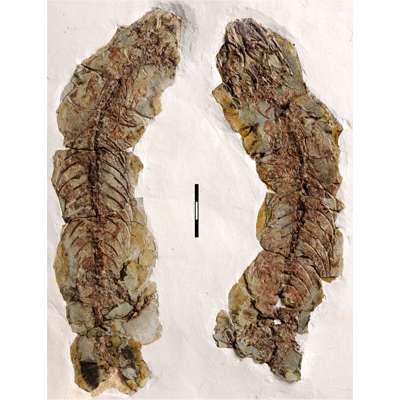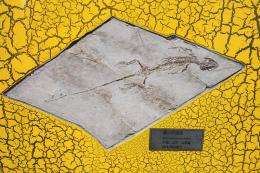July 22, 2011 report
Oldest pregnant lizard fossil discovered


(PhysOrg.com) -- A new paper published in Naturwissenschaft reveals a fossil from 120 million years ago that proves that some lizards were not laying eggs but rather giving birth to live young.
The fossil was discovered by Susan Evans, a professor from the University College London Department of Cell and Developmental Biology, in the Jehol region of Northeast China. This area has revealed hundreds of dinosaur, amphibian, reptile, fish, bird, mammal, invertebrate and plant fossils.
The lizard in this case has been identified as Yabeinosaurus which scientists believe to be similar to the gecko. Evans did not pay much attention to the fossil when it was first discovered but Yuan Wang from the Chinese Academy of Sciences examined the fossil and discovered 15 tiny fossilized embryos.
The embryos were almost fully developed and the researchers believe that the foot-long mother died only a few days before she would have given birth.
This discovery reveals that some lizards were giving birth to live young in the Early Cretaceous period. Previous fossils have shown that some marine lizards gave birth to live young but this is the first primarily land lizard to be discovered.
“We previously thought that lizards adapted to live birth after mammals, but now it looks like it happened at roughly the same kind of time. This specimen is the oldest we have seen, which implies physiological adaptations, like adequate blood supply to the embryos and very thin shells - or no shells at all - to allow oxygen supply, evolved very early on,” said Professor Susan Evans.
For lizards the added weight throughout the gestational period can limit their movement and ability to flee from predators. This lizard was believed to have lived on a river bank or somewhere close to water where it was able to flee to water in order to move easier.
"We do know that this lizard lived near to water and we think it likely that they could swim even though they primarily lived on land. This would make sense as a pregnant lizard would be less constrained by carrying offspring – she’d be able to escape into water if a hungry dinosaur came along!” she added.
More information: A gravid lizard from the Cretaceous of China and the early history of squamate viviparity, by Yuan Wang and Susan E. Evans, Naturwissenschaft, DOI:10.1007/s00114-011-0820-1
Abstract
Although viviparity is most often associated with mammals, roughly one fifth of extant squamate reptiles give birth to live young. Phylogenetic analyses indicate that the trait evolved more than 100 times within Squamata, a frequency greater than that of all other vertebrate clades combined. However, there is debate as to the antiquity of the trait and, until now, the only direct fossil evidence of squamate viviparity was in Late Cretaceous mosasauroids, specialised marine lizards without modern equivalents. Here, we document viviparity in a specimen of a more generalised lizard, Yabeinosaurus, from the Early Cretaceous of China. The gravid female contains more than 15 young at a level of skeletal development corresponding to that of late embryos of living viviparous lizards. This specimen documents the first occurrence of viviparity in a fossil reptile that was largely terrestrial in life, and extends the temporal distribution of the trait in squamates by at least 30 Ma. As Yabeinosaurus occupies a relatively basal position within crown-group squamates, it suggests that the anatomical and physiological preconditions for viviparity arose early within Squamata.
© 2010 PhysOrg.com
















